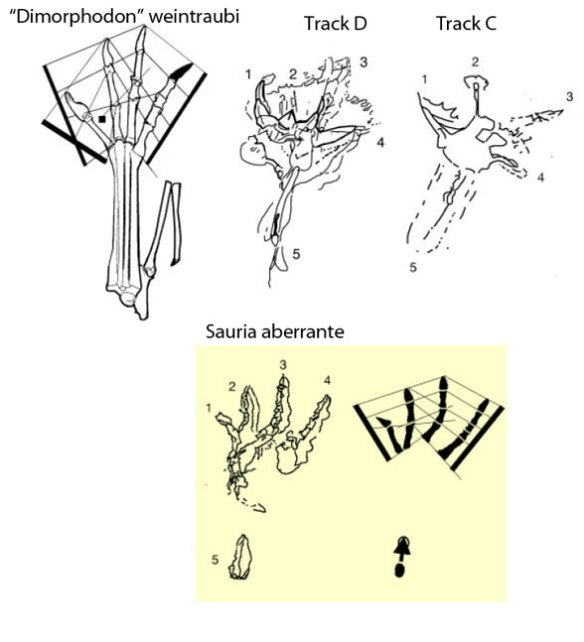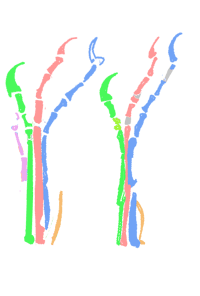Updated June 14, 2021
with a new tracing of Martensius, a new sister for Tetraceratops.
Spindler 2020 brings new insight
to the problematic skull of Tetraceratops insignis (Figs. 1, 3-5; Matthew 1908). Traditionally considered a basalmost therapsid, it moves back just a notch when Spindler reports, “New information on ‘pelycosaurian’ character variation and relationships indicates that Tetraceratops represents a haptodontine-grade or (less likely) sphenacodontid ‘pelycosaur’.”

Figure 1. Tetraceratops fossil with tracing by Spindler and colors added using DGS methods. Here the quadrate (q) is a tabular + supratemporal. The pteryoid (pt( is a squamosal. The postorbital (po) is a postorbital + postfrontal + parietal. Some squamosal pieces are inside the orbit. Note the cervical rib (not colored) where the brain used to be. That’s the medial mandible exposed, not the lateral.
By contrast
the large reptile tree (LRT, 1635+ taxa) now nests Tetraceratops between Saurorictus (Fig. 4) and the Limnoscelis (Fig. 4) clade (including Tseajaia and Orobates (Fig. 4)). The better data from Spindler 2020 moved Tetraceratops from a sister to Tseajaia, where the LRT nested it in 2011, prior to its new nesting. So this is a correction and a refinement.

Figure 2. Subset of the LRT focusing on Tetraceratops and its closest relatives.
A basic theme in most of these posts
is how to deal with convergence. In this case, the Milleretta (Fig. 4) clade produces all higher Lepidosauromorpha, including turtles, pareiasaurs, diadectids, Lepidosauriformes and Caseasauria, a clade traditionally associated with basal pelycosaurs… until tested with these other pertinent taxa.
Let the software decide where clades nest.
Don’t exclude candidates before testing them. That’s what the LRT does.
Even in 2020
Limnoscelis is not traditionally considered a reptile, let alone one related to Milleretta and Orobates, as indicated here in the LRT (subset Fig. 2).

Figure 3. Tetraceratops compared to several haptodine and basalmost therapsid taxa, the closest relatives according to Spindler 2020. Taxa at the transition from basal pelycosaurs to basal therapsids are well represented with subtle differences indicated.
Another theme is accurate reconstruction.
DGS (digital graphic segregation) permits specimen reconstruction without any freehand skills and attendant biases. Just copy and paste and let the reconstruction build itself in several views. Better interpretation comes with time and experience.

Figure 4. Tetraceratops and LRT relatives including Saurorictus, Limnoscelis, Orobates and Milleretta. Compare occiputs were preserved.
There is no argument about the well-preserved
and well-articulated anterior regions of the skull of Tetraceratops. The tusk like anterior premaxillary teeth find homologs in Limnoscelis.
The deeply curved mandibles
and narrow skull bauplan do not find homologs in currently tested taxa near Limnoscelis, but again, the larger anterior dentary teeth find homologs in Limnoscelis. These traits, as it turns out are convergent with those of basal pelycosaurs, which is a major cause for prior confusion.
The premaxilla of Tetraceratops is broader ventrally, taller, and more robust than in basal pelycosaurs. It more closely resembles the premaxilla of Limnoscelis.
The mandible is exposed in medial (not lateral) view. So a pelycosaur-like retroarticular process is not visible.
More questions attend the post orbital region of the skull.
In the present interpretation the squamosal was broken and displaced during taphonomy. Something pushed the neck into the back of the skull creating displacement and damage. Related taxa have a similar tall straight post-jugal + post-postorbital rim, which was considered the rim, of a very large lateral temporal fenestra by other workers, including Spindler 2020. It is easy to see why workers thought that, especially when combined with the curved mandible. Putting that broken and rotated squamosal plus quadratojugal back in place (the curves match perfectly) is paramount to this new understanding.
The postorbital portion of the Tetraceratops skull
is shorter than in all other tested taxa, which makes it strange, but note the match with the mandible for reconstruction confirmation. Only Orobates (Fig. 4) s similar, but still longer.
The present reconstruction
(Fig. 5) indicates a narrow cranium in dorsal view, as Spindler notes, but a much broader palate is shown in the reconstruction, as in Limnoscelis, distinct from basalmost pelycosaurs, which have a narrow cranium and a relatively narrow palate.
The only other taxon with expanded prefrontals,
as seen in Tetraceratops, is Orobates, but to a lesser extent. Despite its plesiomorphic phylogenetic nesting, Tetraceratops has several derived traits not expected in the last common ancestor of Limnoscelis + Tetraceratops.

Figure 5. Tetraceratops tracing using DGS and freehand illustration by Spindler 2020. Note the occiput has been pushed anteriorly and up, like a garage door. A single cervical vertebra appears in the in situ opening between the occiput and parietals.
Testing
Following Spindler 2020 and others, I moved Tetraceratops to the base of the Pelycosauria in the LRT. That move adds a paltry 15 steps, demonstrating the great convergence in the two clades. Deleting all Lepidosauromorpha, other than Tetraceratops, nests it with Silvanerpeton. That’s where the Lepidosauromorpha would be, if not deleted, and far from the basal pelycosaurs trying to attract it.
Spindler 2015 reviewed the possibility of a sistership with Tseajaia,
but did so by cherry-picking a few traits (narrow skull, pterygoid transverse flange with strong dentition, bass-parasphenoid narrow and ventrally grooved, a real diastema, synapsid fenestra), thereby, “Pulling a Larry Martin.” The only way to really test taxa is to add them to a wide gamut phylogenetic analysis, like the LRT, that uses hundreds of traits and 1630+ taxa. Note, the new data moved Tetraceratops to a more primitive node relative to Tseajaia. So you have to test more taxa than just Tseajaia to resolve this issue. Better data sheds new light on many issues.
Spindler 2015 reports, “The main point of criticism is that the tests communicated by D. Peters did not use character lists and OTU lists capable of resolving a particular question. For example, plotting Tseajaia in the matrix of Liu et al. (2009) will count few similarities with Tetraceratops as synapomorphic, whereas the plesiomorphic features appear as autapomorphic in this pseudo‐clade for the lack of polarizing outgroup information. The suggested analysis ignores the requirement of matrix constraints that are designed for specific questions.”
Liu et al. 2009 were considering the nesting of a new basal synapsid with double canines (Raranimus), completely unrelated to Tseajaia. In that cladogram Tetraceratops nested with Dimetrodon. Haptodus was the outgroup taxon and lateral temporal fenestra were presumed for Tetraceratops.
That brings to mind the possibility of an interesting test:
Where would Tseajaia, Tetraceratops, Limnoscelis and Saurorictus nest in a similar restricted test of Pelycosauria and basal Therapsida, with Haptodus as the outgroup taxon? The LRT and PAUP makes this easy by simply deleting taxa to the match the target taxon list. Results include the following:
- Tseajaia alone nests without resolution with Haptodus, the two pelycosaur clades and the therapsid clade.
- Tetraceratops alone nests without resolution with Ianthodon and the two pelycosaur clades.
- Limnoscelis alone nests without resolution with Pantelosaurus and Cutleria + Hipposaurus.
- Saurorictus alone nests without resolution with Ianthodon and the two pelycosaur clades.
- All four added at once: They all nest with complete resolution as a sister clade to Pelycosauria.
Reverse testing
Going the other way, adding Pantelosaurus and Haptodus (Fig. 3) to a subset of the LRT focusing on Tetraceratops and its Lepidosauromorph kin nests those two taxa five nodes away from Tetraceratops, closer to the base of turtles + pareiasaurs.
Yes, any cladogram will nest every taxon,
with or without resolution. More characters do not produce greater resolution. More taxa, working like a larger diameter telescope, produces greater resolution, while increasing confidence in the results by further minimizing taxon exclusion.
A review of the the figures above
demonstrates the distinct convergence between the two unrelated clades, a convergence that is best tested and resolved by phylogenetic analysis using a wide gamut of taxa. No polite dismissal of candidate taxa based should be considered, no matter how obvious such a dismissal appears warranted. Let the software sort out where every taxon nests. It worked for Casesauria. It worked for Tetraceratops, too.











































